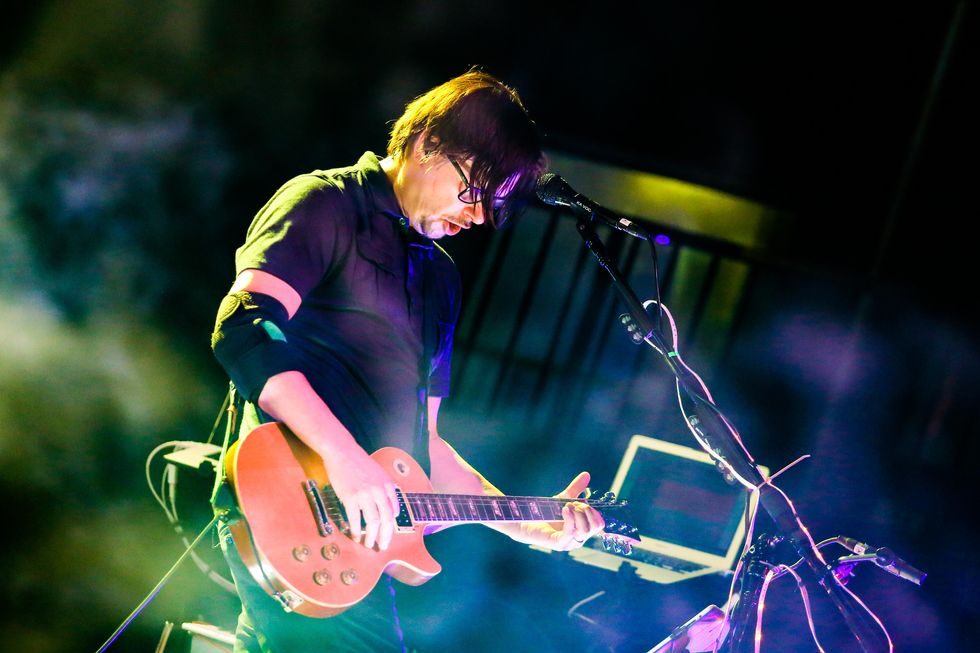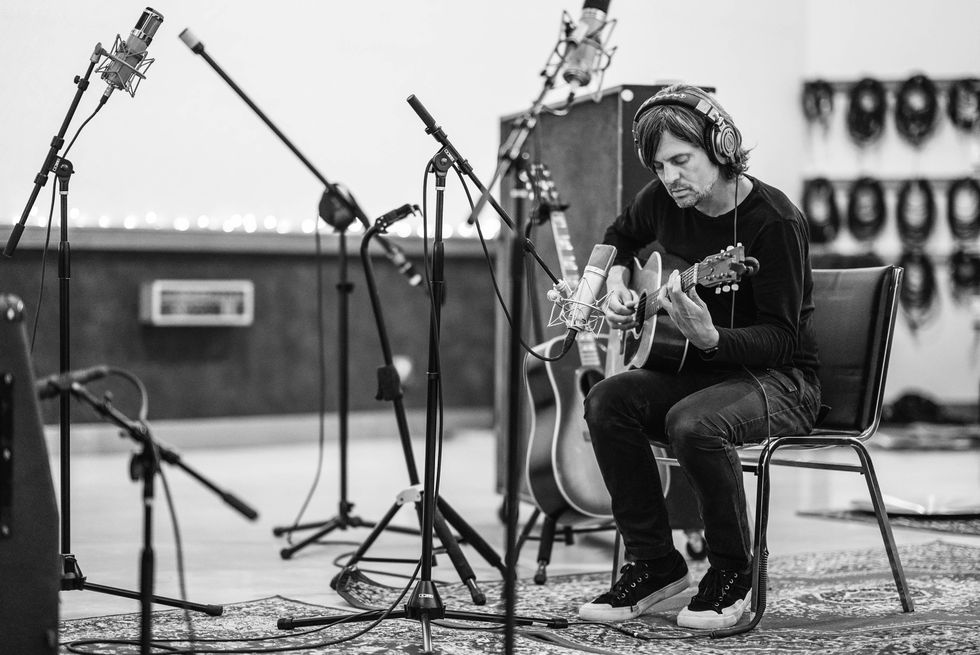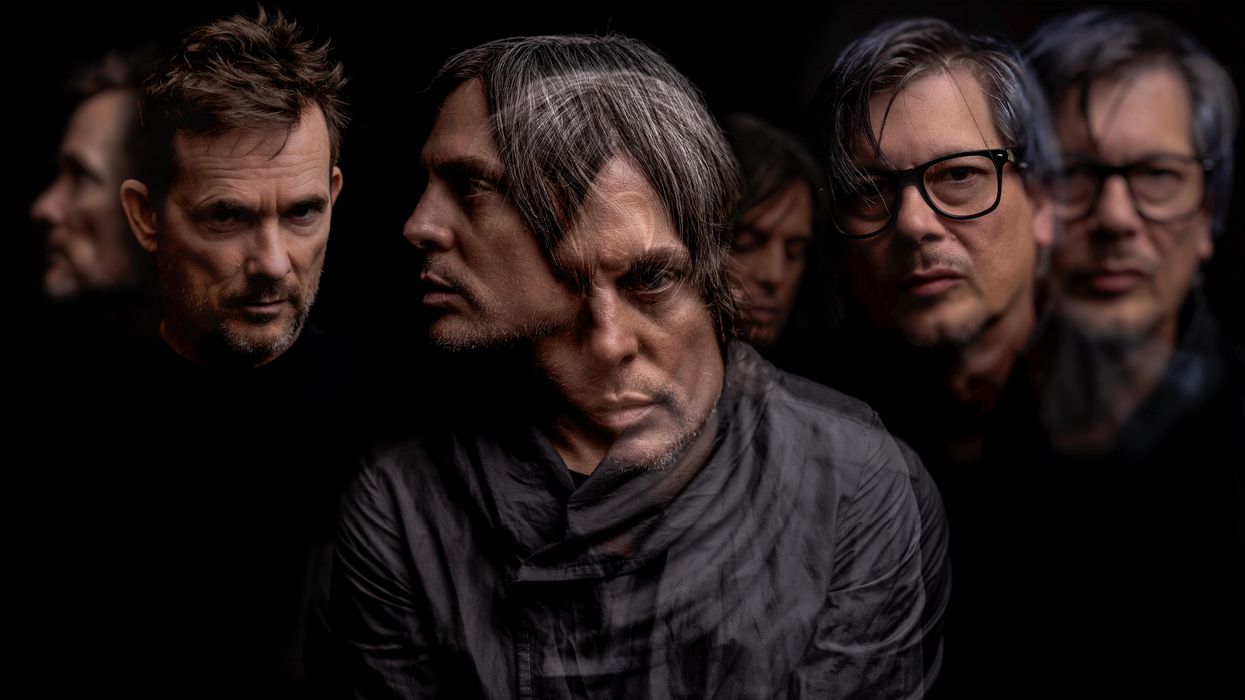Failure was one of the most underrated bands of the 1990s. As they crafted their early groundbreakers Comfort (1992) and Magnified (1994), they developed a hardcore following, toured with and befriended Tool, played the Lollapalooza main stage, and got rotation on MTV. All that momentum culminated in their career-defining 1996 album Fantastic Planet. A quarter-century later, the band—co-founders Ken Andrews and Greg Edwards on shared vocals, guitar, bass, and keyboards, alongside drummer Kellii Scott—have released what may be their next classic, Wild Type Droid.
But getting here wasn’t smooth sailing. The blissful ignorance that Andrews and Edwards say brought Failure success in the ’90s is also what nearly destroyed them. “So much of what I did on guitar on that first album, I had no idea what I was doing,” says Andrews. “That brought something different to it.” Edwards agrees, adding, “We discovered as it went.”
While that approach opened the doors to creativity, it also brought frustration. “We knew when we were making Comfort that it wasn’t turning out the way we hoped,” Andrews relates. “Even on Magnified, there was this feeling of, ‘Dude, did we nail that? I’m not really sure.’ Case in point, the label actually wanted to release the demos for Magnified, as opposed to what we turned in as the finished thing. It was a struggle finding what our sound was until we took the reins for Fantastic Planet.”
Failure - Headstand - Music Video
Even on that self-produced album, which Edwards describes as “really spread out” and eclectic, the band was searching. He explains, “When I demoed the idea for ‘Blank’ or ‘The Nurse Who Loved Me,’ I remember thinking, ‘These can’t be Failure songs.’ But they became staple Failure songs!”
Things soon came undone, and in 1997, at the height of their career, Failure broke up. Instead of headlining shows with their crushing space riffs, the guys moved on to other bands and projects, which for Andrews included some A-list pop studio credits with Nine Inch Nails, Paramore, Andrew W.K., and Tenacious D. Though they were staying busy, the fans were left without until 2013, when Andrews, Edwards, and Scott announced their reunion.
Far from a ’90s nostalgia trip, Andrews says the band wanted their return to be more intentional: “When we rebooted, and once we realized that the Failure sound is unique to these brains, it became more of a consideration of, ‘If we’re going to make music together, what kind of music is it going to be?’” Their subsequent albums The Heart Is a Monster and In the Future Your Body Will Be the Furthest Thing from Your Mind proved as vital, creative, and driven as ever.
"Even if we hadn't done what we did in the '90s, I still feel like what we're doing now is cool." —Ken Andrews
Now, on Wild Type Droid, Failure sound like a robust and streamlined machine with a renewed focus, incorporating new tones alongside their signature mammoth riffs, cosmic themes, and dissonant harmonies. That’s due at least in part to a fresh and in-the-moment recording approach. “In the Future was written by forcing the songs into being,” says Edwards. “With this new process, we committed to going into a room together for a month and recording—four or five days a week, and five, six hours a day—everything we played. It was very organic.”
Hours upon hours of jamming and creatively searching for new ideas did take a toll. Andrews says that process informed the sound of the album, calling it “a conscious decision to enter this mode of only improvising and not putting on the songwriter hat. That was a unique decision that I think paid off because it gave us this huge well of material. You can’t recreate that in a songwriting workshop studio thing. It’s that intangible randomness that happens when you have three brains working at the same time.”

TIDBIT: The songs on Wild Type Droid were written in long, jam-style sessions—a first for the band. That approach, along with the addition of a baritone guitar and Bass VI, encouraged new ideas and sounds.
And while it lead to exhaustion in the studio, Edwards sees that as an asset and likens it to “Kubrick’s theory of doing way too many takes. You exhaust the actor, and after you go through all the terrible takes, all of a sudden, you transcended into another state of consciousness, and interesting stuff starts happening.”
With both guitarists playing equal shares of guitar and bass, how do the songs begin? It’s as simple as one of them picking up an instrument. “I would see an instrument that I hadn’t played yet, grab it, then start making noise,” said Edwards. “Kellii would start playing a beat, and then all of a sudden, we’d be into something.”
With that in mind, Andrews introduced two new pieces of gear, hoping they would be inspiring. He was right, and Edwards quickly took to one of them: a Danelectro baritone. “This was my first experience playing baritone,” he says. “And because it’s what I always do, a lot of my baritone parts are way up on the neck. It had a different quality than anything I’d heard from a guitar. ‘Long Division’ is a good example.”
Failure's Gear

Ken Andrews, seen here with a Les Paul, has accumulated top-level studio credits through the years, working with artists such as Nine Inch Nails and Tenacious D.
Photo by Debi Del Grande
Guitars
- Danelectro baritone
- Squier Bass VI
- 1976 Gibson Les Paul
- Gibson Explorer
- Fender Jazzmaster
- Vintage Gibson LG-1
Amps & Effects
- Fractal Audio Axe-Fx III
Strings & Picks
- Ernie Ball Power Slinky Bass (.040–.-95)
- Ernie Ball Baritone Slinky (.013–.072)
- Ernie Ball Burly Slinky (.008—.038)
- Dunlop Tortex .60 mm, .73 mm, .88 mm
Andrews’ other new addition was a Squier Bass VI. Failure has always placed bass front-and-center, driving their music with grinding tones and low-octave chords, so the Bass VI was an easy fit. “We’ve been playing chords on 4-string bass for a very long time,” says Andrews, “but I found that when I was playing the Bass VI it’s a different quality. You can hear it on ‘Submarines’ and ‘Long Division.’”
Although there are appearances by a Jazzmaster, a new Gibson Explorer, and Andrews’ 1976 Les Paul, the Danelectro and the Bass VI defined the album. Failure’s other secret weapon was their trusty Fractal Audio Axe-Fx IIIs. “We were using presets and scenes from previous songs, from previous albums, even ’90s songs. And I’ve been using the Fractal since 2014, so I’m quite familiar with the unit,” says Andrews. “If I had recorded a DI track during writing, I could completely reconstruct the sound, hearing it in context with the final vocals at the end. There were several songs where, literally, I was playing back DI bass and DI guitar while essentially mixing them on the Fractal.”
The refined sounds of Wild Type Droid’s woven tapestry of guitar and bass are a reminder that the Failure guitarists also geek out on production techniques. Reminiscing about the band’s early years, Andrews says, “I remember having long discussions [with Edwards] about production, more than individual riffs and parts. We were very aware of how impactful production can be on establishing an emotional mood that you get from listening to music. It became an obsession, in a way.”
“So much of what I did on guitar on that first album, I had no idea what I was doing. That brought something different to it.”—Ken Andrews
That obsession pays off throughout Wild Type Droid, helping the album sound meticulously crafted while never losing Failure’s raw, straightforward character. Songs like “Headstand” and “Bad Translation” take the best of Fantastic Planet’s power, dissonance, and pop sensibilities, and amplify them. Andrews and Edwards chalk that up to their creative connection, strengthened by decades of making music together.
“Everything was very much about listening to the other person and saying, ‘What can I play that’s not stepping on that?’” says Edwards. “That’s a product of an evolving sensibility within the band members over many years,” Andrews continues. “We’re looking now at the challenge of complementing things, as opposed to doubling and strengthening things.”
Failure’s albums sound better than ever, they still have a loyal fan base, and their new release is a musical success, but the 6-string duo are quick to mention how hard survival has been in the music industry. “In the ’90s, being signed was the biggest factor in what we were doing at any given time,” says Andrews. “And if you weren’t signed in the ’90s, you weren’t taken seriously,” chimes in Edwards.

In the studio working on Wild Type Droid, Greg Edwards lays down a track with a vintage Gibson LG-1.
Photo by Priscilla Scott
But Andrews points out that being on labels had its share of problems. “We were basically on their schedule,” he says. “We couldn’t release the record if they didn’t want to do it, we couldn’t tour, we couldn’t do anything. It was all about promoting our band within our own label to get them to pay attention and do stuff for us.”
Today, that business model is dead, and most record labels have all but given up on album sales as a major revenue stream. “It’s crazy when you think about how much it changed from 2005 to 2012, and then from 2012-ish to now,” says Edwards.
“It was a whole different thing,” agrees Andrews. “I remember when record companies started sniffing around our shows. I went to the bookstore and got Donald Passman’s book about the business of music [All You Need To Know About the Music Business]. In that book, the first thing he says is, ‘Do not try to force yourself into the public eye or into the music business. You have to be invited in,’ which sounds kind of crazy in 2022. What’s even left to invite you into?”
“It’s like Kubrick’s theory of doing way too many takes. You exhaust the actor and after you go through all the terrible takes all of a sudden you transcended into another state of consciousness, and interesting stuff starts happening.”—Greg Edwards
Today’s uneasy music industry is all about streaming services, and Spotify sits comfortably at the top. But they’ve seen a steady trickle of artists challenging their platform or, as Neil Young did very publicly, abandoning the service altogether. Recently, Failure announced their decision to do the same. Though the day’s politics played a role, the band said it was inevitable and a long time coming. And since most artists don’t make much from Spotify streams anyway, leaving the platform wasn’t a major financial setback.
“Spotify, in some sense, is the streaming arm of whatever you want to call the major-label world,” says Andrews. “But it’s completely flipped on its head. It’s all about aggregating the most content possible and paying the lowest possible for individual streams. If you really game it out, how does Spotify exist past another 10 years? Eventually, musicians won’t want to use a service that doesn’t give anything back to them. That’s what happened to us.”
Andrews says Failure is in a better place now than during their first go-round. “I’m enjoying the process way more than I did in the ’90s. Even if we hadn’t done what we did in the ’90s, I still feel like what we’re doing now is cool. Why would you stop doing something when you feel like you’re getting more appreciation for it? I feel like we’re this independent, little business that happens to be a band. And we’re surviving.”
Failure - Another Space Song (Live on KEXP)
Greg Edwards’ clear, chime-y arpeggios float over the mesmeric groove created by Ken Andrews’ growling bass line and Kellii Scott’s repetitive kit work in this 2015 version of “Another Space Song” from Fantastic Planet.

















![Rig Rundown: Russian Circles’ Mike Sullivan [2025]](https://www.premierguitar.com/media-library/youtube.jpg?id=62303631&width=1245&height=700&quality=70&coordinates=0%2C0%2C0%2C0)








